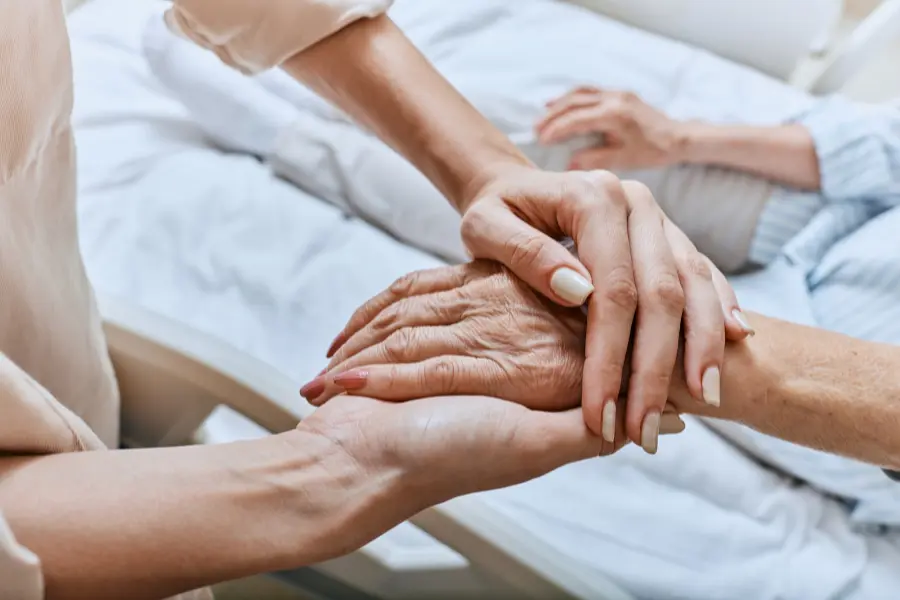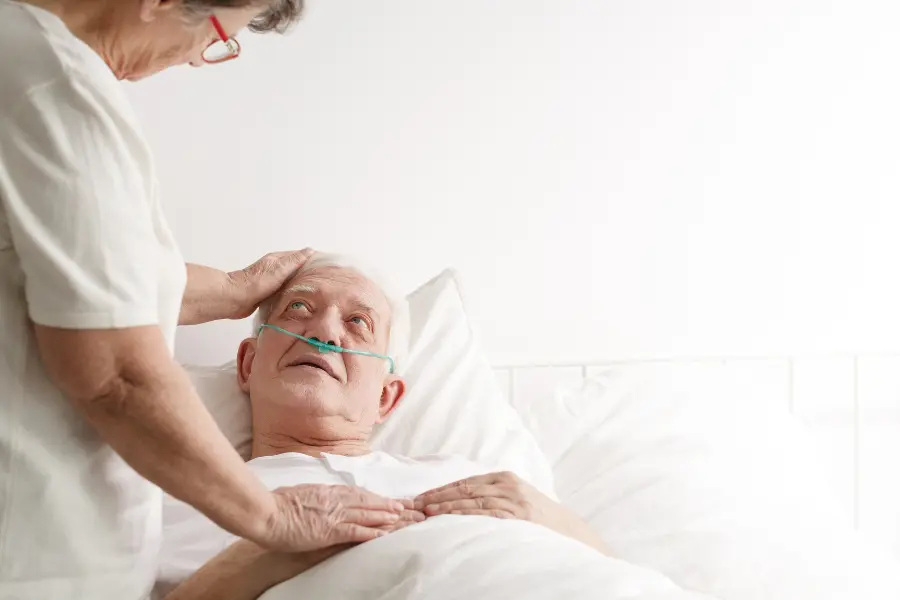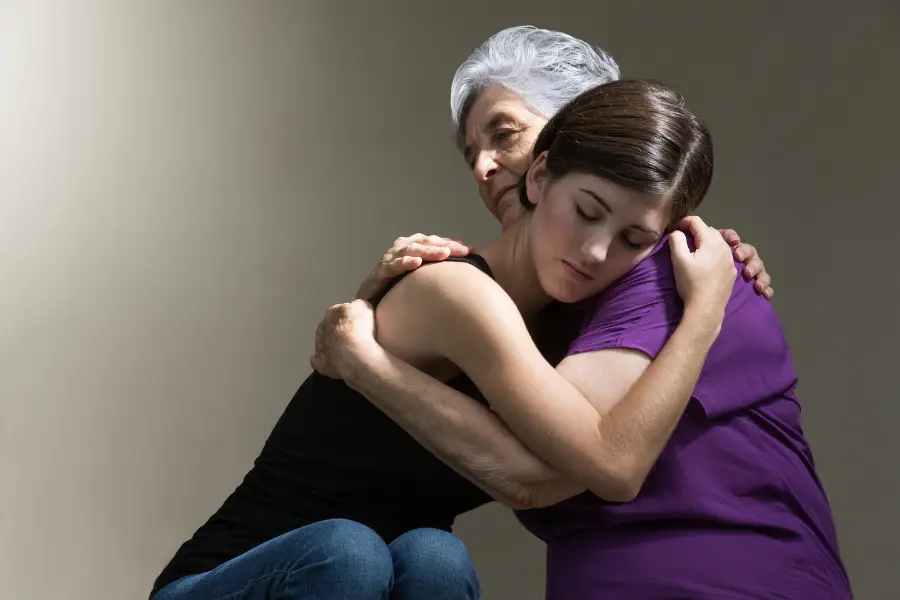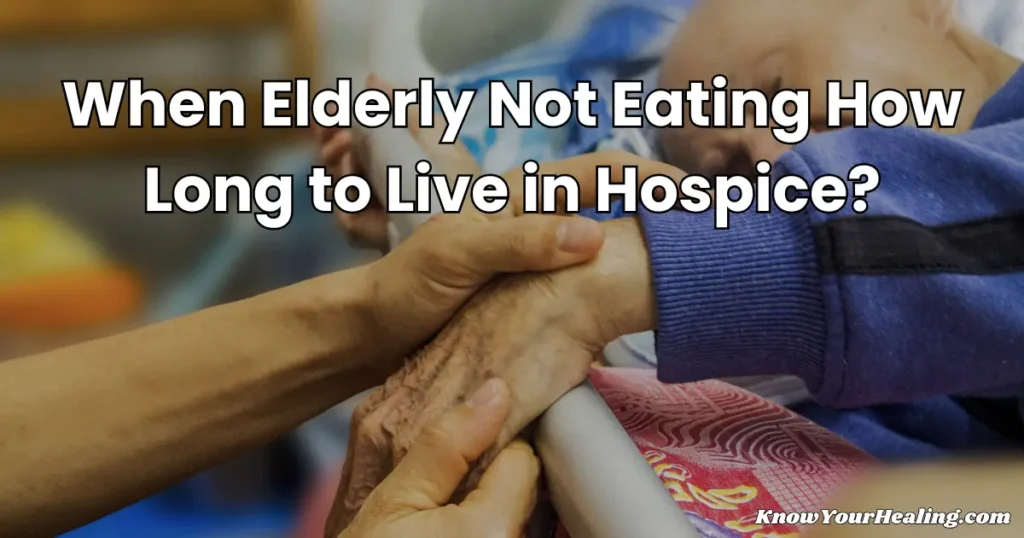How long can the elderly live without water in hospice care is a question that families face during some of their most difficult moments.
Most hospice patients typically survive three to five days without water, although this timeline can vary significantly depending on individual circumstances and overall health.
When a loved one enters hospice, understanding the natural process of declining food and water intake becomes vital for families preparing for end-of-life transitions.
The body’s changing needs during this time raise concerns about comfort, dignity, and what to expect in the coming days.
This guide looks at the medical realities behind hydration changes in hospice patients. It also explores how families can focus on providing emotional support and maintaining quality of life during these final stages.
Typical Timeline Without Water in Hospice Care

Hospice patients typically survive 3–5 days without water, but in some cases, survival can last up to 10 days or more. Medical conditions, activity, and overall health all play a significant role in this timeline.
Average Survival: 3–5 Days Without Water and Its Impact on Vital Organs
The duration elderly individuals can live without water in hospice care typically ranges from three to five days. Most hospice patients survive for three to five days without water, but there are always exceptions.
The body starts to change within 24–48 hours after stopping fluids. Blood pressure drops as circulation becomes harder to maintain. Vital organs function less efficiently as dehydration gets worse.
Key physiological changes include:
- Decreased kidney function within 24 hours
- Reduced oxygen levels affect organ performance
- Compromised heart function due to thickened blood
- Altered body temperature regulation
Healthcare professionals closely monitor these changes. The hospice team focuses on comfort rather than prolonging life through artificial means.
Dry mouth is often one of the first symptoms, and comfort care like ice chips or lip balm usually helps.
Extreme Cases: Up to 10 Days and Beyond (rare instances, life expectancy)
Some terminally ill patients survive more extended periods without water. A few hospice patients may live up to 10 days without fluid intake, especially if they’re bedridden and have lower fluid requirements.
Life expectancy sometimes extends in rare situations when patients have:
- Lower metabolic demands from reduced activity
- Kidney disease affects fluid processing
- Heart failure changes fluid requirements
- Cancer patients with specific tumor types
Environmental factors matter too. Hot climates accelerate dehydration, while cooler rooms may extend survival time slightly.
Body functions slow down a lot after the first day, and most patients become unconscious within 72 hours.
Individual Factors: Medical Conditions, Activity Levels, Environmental Conditions, and Overall Health
Several factors influence the duration of hospice patients’ survival without adequate hydration; overall health before stopping water intake matters.
Older people with healthier kidneys may handle remaining fluids differently than those with organ failure.
Medical conditions affecting survival time:
- Kidney disease can extend the timeline due to altered fluid processing
- Heart failure changes circulation patterns
- A history of severe dehydration may shorten survival
- Muscle mass influences fluid reserves
Activity levels change fluid needs. Bedridden patients at the end of life typically require less water than those who are still mobile.
Environmental conditions matter—a cool, air-conditioned room might extend things a bit compared to a hot one.
Healthcare professionals consider these factors when talking with families. The dying person’s previous health provides clues about how long the process might take.
Anecdotal Reports: Weeks Without Water—How the Body Manages
Sometimes, medical professionals observe patients surviving for weeks without fluids. Some healthcare workers have seen patients live up to three weeks without food or water, though most people lose consciousness after a few days.
The body manages these longer periods with a few mechanisms:
- Metabolic slowdown reduces fluid needs
- Kidney conservation of remaining fluids
- Cellular adaptation to dehydration
- Reduced bodily functions to minimize water loss
These cases usually involve specific medical conditions or treatments. Hospice professionals point out that quality of life during these extended periods is typically marked by unconsciousness.
Role of Hospice Team Decisions in Hydration, Artificial Nutrition, and Comfort Care
Hospice professionals make key decisions about hydration and nutrition based on the patient’s wishes and comfort. The team considers whether interventions like feeding tubes fit end-of-life care goals and palliative care principles.
Key team considerations include:
- Patient’s comfort versus life-sustaining treatments
- Family input on care decisions
- Medical condition progression
- Quality of life assessments
Compassionate care focuses on emotional and spiritual support, rather than prolonging the dying process. Hospice nurses provide oral hygiene, pain relief, and comfort measures, such as ice chips for dry mouth.
The team helps families understand that withholding artificial nutrition is a natural part of the dying process.
Physiology and Comfort—Why Hydration Changes in the Final Stages

How long elderly people can live without water depends on natural body changes that happen during the end-of-life stages.
The body undergoes significant shifts that reduce thirst and alter its fluid handling, so traditional hydration methods may make dying patients less comfortable.
The Body’s Natural Shift: Decreased Sense of Thirst and Digestive Decline
The body naturally reduces hunger and thirst as part of the dying process. This built-in mechanism helps protect patients from discomfort in their last days.
Elderly individuals often experience significant changes in the function of their digestive systems.
Kidneys and other organs begin to slow down. That means the body needs less fluid than it did before.
Key physiological changes include:
- Decreased kidney function and urine production
- Reduced saliva production leading to dry mouth
- Slower digestion and less food intake
- Lower activity levels, so less hydration is needed
Trying to force water can do more harm than good. The body’s natural wisdom guides it to need very little hydration at the end.
Symptoms: Dry Mouth, Lip Care, and Oral Hygiene
Dry mouth is one of the most noticeable symptoms when water intake decreases. Families often worry about it, but good oral hygiene brings real relief.
Ice chips are a simple way to moisten the mouth without stressing the digestive system. Just a little can offer comfort. Lip balm helps prevent cracking and keeps the patient more comfortable.
Effective comfort measures include:
- Gentle mouth swabs with water
- Small ice chips for moisture
- Regular lip balm
- Soft toothbrush cleaning
The hospice team typically guides patients in using the most effective oral care techniques. These small steps can improve quality of life without adding stress.
Hydration Risks: Edema, Shortness of Breath, Reduced Oxygen Levels
Too much fluid can actually cause real problems for patients near the end of life. The body can’t process fluids as well, so they build up in tissues and organs.
Weeping edema can become a big issue if patients get too much water. Fluid may leak through the skin, causing discomfort and potentially leading to skin breakdown.
Extra hydration can also cause shortness of breath when fluid pools in the lungs. That can drop oxygen levels and make patients feel worse.
Blood pressure can also shift, as the heart and blood vessels struggle to cope with the extra fluid.
Terminal Dehydration as Part of the End-of-Life Process
Terminal dehydration is a regular part of dying, not a medical emergency that needs intervention. Understanding that lack of fluids is a normal part of the dying process helps everyone involved navigate these challenging moments.
The dying body conserves energy by reducing non-essential functions. That means less thirst and lower fluid processing. Hospice professionals see this as a natural way the body prepares for death.
Terminal dehydration often brings more comfort than distress. It can reduce pain and create a more peaceful transition in the final stages.
Palliative Care and Decisions on Artificial Hydration
Palliative care teams work with families to make decisions about artificial hydration. A feeding tube is one option, but it doesn’t always improve the quality of life for terminally ill patients.
The hospice team assesses each patient’s comfort and medical situation before recommending hydration methods tailored to their specific needs. Patient wishes matter a lot in these moments.
Compassionate care means prioritizing emotional and spiritual support over aggressive treatments. The primary goal is to ensure comfort and dignity in the final stages of life.
Family, Emotional Support, and Quality of Life During Dehydration

How long someone can live without water becomes less important than offering real compassion in their final days. Families face tough emotional challenges, while hospice professionals keep the focus on patient comfort with supportive measures.
Emotional Impact on Family Members When Patients Stop Drinking
Family members often feel deep worry when a loved one refuses water. It’s natural—they believe fluids are essential for survival. Many feel helpless watching their loved one’s intake decline.
The hospice team helps families understand that reduced water intake is a normal part of dying. Healthcare professionals explain this, which can ease some anxiety.
Guilt is common, too. Some relatives worry they aren’t doing enough to encourage drinking. Support groups and counseling can help families see that forcing fluids may actually cause more harm than good.
Comfort Techniques: Ice Chips, Moistening Mouth, Lip Balm, and Soothing Touch
Ice chips can soothe dry mouth without flooding the patient with fluids. Small pieces melt slowly, providing cooling relief. The hospice nurse can show family members how to offer ice chips safely.
Oral hygiene becomes even more critical when water intake decreases. Gentle mouth swabs with water or special solutions help keep the mouth moist. Lip balm prevents cracking and adds comfort.
Soothing touch goes a long way, too. A gentle handhold or soft stroke can bring comfort and connection in a way that medical treatments just can’t. Sometimes, these simple gestures matter most.
Honoring Patients’ Wishes and Care Plans
Care plans should align with what the patient wants for their quality of life, rather than merely prolonging the dying process. Many older adults discuss artificial nutrition and hydration before things become critical.
These wishes matter, and both families and doctors ought to respect them. Advanced directives guide decision-making about feeding tubes and IV fluids.
Some patients directly refuse life-sustaining treatments, including forced hydration. Hospice care primarily focuses on comfort, rather than simply adding more days.
Families and hospice teams need to talk regularly as things change. Comfort takes the lead over standard medical routines when someone enters end-of-life care.
Spiritual and Emotional Support Beyond Hydration
Spiritual support extends beyond simply worrying about water or fluids. Many people find peace through prayer, meditation, or their own spiritual practices.
Chaplains and spiritual counselors can help guide families and patients during this time. Emotional needs often outweigh physical requirements in hospice settings.
Conversations and sharing old memories can soothe in ways water simply can’t. Honestly, just being there means more than any push for more fluids.
Quality of Life vs. Prolonging the Dying Process
The quality of life starts to take on a different meaning as a terminal illness progresses. Comfort care puts pain relief and emotional well-being first, not just survival.
Forcing hydration can sometimes make things worse instead of helping. Palliative care principles guide these crucial decisions about hydration and nutrition.
The focus turns from trying to cure to simply supporting and honoring someone’s dignity. This shift can help families come to terms with what’s happening.
Final Thoughts
How long elderly patients live without water in hospice really depends on the person. Most hospice patients can survive 3-10 days without water, although the timeline varies depending on their overall health.
Key Takeaways: Elderly hospice patients often survive 3-10 days without water. Those truly at the end need less hydration because their energy needs drop.
Family comfort and dignity should guide hydration decisions during this time.
Important Factors That Affect Survival:
- Current health condition
- Body size and weight
- Environmental temperature
- Previous hydration levels
- Medications being taken
The main thing is to focus on comfort and dignity, not just stretching out life. Elderly individuals can survive around three days without water in normal situations, but in hospice, it’s a different story.
Families should maintain close contact with hospice teams to make informed decisions. Mouth swabs and ice chips can help without forcing unwanted fluids.
Everyone’s journey is different. Medical professionals can help families navigate these difficult choices while prioritizing comfort.
Have something to add? Toss it in the comments, and sign up for our newsletter if you want more stories like this.
How long elderly patients can live without water is a deeply personal question that requires compassionate guidance from a skilled medical team.
Frequently Asked Questions
Families often have numerous questions about water intake and survival time during end-of-life care. Knowing the timeline and what to expect physically can help caregivers prepare themselves.
End-of-life patients can survive 8 to 21 days without water, but it varies a lot. Some people may live only a few days or hours after stopping water intake. The body’s response really depends on overall health. In rare cases, some patients last several weeks.
Patients often become less responsive and sleep more in their final days. Breathing patterns might change, becoming irregular or shallow. The skin can feel cool and look pale or mottled. Appetite and thirst usually drop off as the body prepares for death.
Forcing fluids can cause physical problems and discomfort in dying patients. The body loses its ability to handle fluids, which leads to swelling in the feet, legs, and hands. IV fluids can even cause dangerous lung swelling, making it harder to breathe. This can lead to coughing and low oxygen levels.
Most people without access to food can survive for about 10 days, although some may pass away within a few days. Others might survive several weeks, but that’s rare. The timeline ultimately comes down to the medical condition and the body’s reserves. Each person’s body reacts differently.
Common signs include less consciousness and longer sleep. The person may stop eating and drinking altogether. Breathing often becomes more labored or irregular. Hands and feet may change color as circulation decreases and the skin cools.
Bedridden elderly patients can live months or even years, depending on health issues. That timeline gets much shorter when they stop eating and drinking. Heart function, kidney health, and overall condition all play a part. Regular care has a significant impact on how long someone lives.
Active dying usually happens in the last few days or hours. The person becomes unresponsive, and their breathing changes significantly. Body temperature drops, and circulation slows way down. Sometimes, you’ll hear rattling sounds when they breathe, due to fluid buildup.
Dehydration can cause symptoms such as thirst, fatigue, and organ failure in its early stages. However, most end-of-life patients naturally stop feeling thirsty. The mouth gets dry and sticky. Urine output decreases significantly or stops altogether.
Hospice care prioritizes comfort over forced hydration. Natural dehydration at the end of life may actually make things less uncomfortable. If the person allows, mouth swabs for comfort are a good idea. Forcing fluids can do more harm than good at this stage.
The pre-active stage usually sticks around for about one to three weeks before someone passes away. During this time, people tend to sleep more than usual. They lose interest in food, and activities no longer appeal to them much. You may also notice that mental confusion is worsening slightly.




